Spatiotemporal Patterns and Determinants of Grain Self-Sufficiency in China
Abstract
1. Introduction
2. Materials and Methods
2.1. Data Sources
2.2. Ration Consumption
2.2.1. Ration Consumption in Rural Areas
2.2.2. Ration Consumption in Urban Areas
2.3. Feed Grain Consumption
2.3.1. Feed Grain Consumption in Rural Areas
2.3.2. Feed Grain Consumption in Urban Areas
2.4. Seed Grain Consumption
2.5. Grain Loss
2.6. Total Grain Consumption
2.7. Total Grain Yield
2.8. Temporal and Spatial Pattern of Grain Yield and Consumption
2.8.1. Analysis of the Direction of Ration and Feed Grain Yield and Consumption
2.8.2. Hot-Spot Analysis in Ration and Feed Grain Consumption
2.9. Temporal and Spatial Pattern of Grain Supply and Demand
2.9.1. Grain Surplus and Deficit
2.9.2. Division of Grain Supply and Consumption
2.10. Determinants of Grain Supply and Demand Pattern
3. Results
3.1. Spatiotemporal Patterns of Grain Production in China
3.1.1. Temporal and Spatial Evolution of Total Grain Yield
3.1.2. Temporal and Spatial Evolution Pattern of Regional Grain Yield
3.2. Spatiotemporal Patterns of Grain Consumption
3.2.1. Temporal and Spatial Characteristics of Grain Consumption Structure
3.2.2. Spatial and Temporal Characteristics of Total Grain Consumption and Grain Consumed in Feed Grain
3.2.3. Spatial and Temporal Differences of Ration and Feed Grain Consumption between Urban and Rural Areas
3.3. Grain Supply and Demand Patterns
3.3.1. Patterns of Total Grain Supply and Demand
3.3.2. Self-Sufficiency Patterns of Feed Grain
3.4. Factors Controlling Patterns of Grain Self-Sufficiency
4. Discussion
4.1. Grain Production in China
4.1.1. Arable Land
4.1.2. Water Resources
4.1.3. Income from Grain Planting
4.1.4. Aging Population and Rural Population to Towns
4.1.5. Global Warming
4.1.6. Agricultural Management and Investment
4.2. Grain Consumption Patterns in China
4.3. Policy Implications
4.3.1. Food Consumption Structure and Dietary Behavior Guidance
4.3.2. Regional Coordinated Development of Grain Consumption
4.3.3. Optimization of the Layout of Grain Production
4.3.4. Countermeasures of Adapting Agricultural Production to Climate Change in China
4.4. Limitations and Directions for Future Work
5. Conclusions
Author Contributions
Funding
Institutional Review Board Statement
Informed Consent Statement
Data Availability Statement
Acknowledgments
Conflicts of Interest
References
- Pan, J.; Chen, Y.; Zhang, Y.; Chen, M.; Fennell, S.; Luan, B.; Wang, F.; Meng, D.; Liu, Y.; Jiao, L.; et al. Spatial-temporal dynamics of grain yield and the potential driving factors at the county level in China. J. Clean. Prod. 2020, 255, 120312. [Google Scholar] [CrossRef]
- Gouel, C.; Guimbard, H. Nutrition Transition and the Structure of Global Food Demand. Am. J. Agric. Econ. 2018, 101, 383–403. [Google Scholar] [CrossRef]
- Zhang, L.X.; Koroma, F.; Fofana, M.L.; Diallo, S.; Lamilé Songbono, J.; Stokes-Walters, R.; Klemm, R.D.; Nordhagen, S.; Winch, P.J. Food Security in Artisanal Mining Communities: An Exploration of Rural Markets in Northern Guinea. Foods 2020, 9, 479. [Google Scholar] [CrossRef]
- Huang, J.; Yang, G. Understanding recent challenges and new food policy in China. Glob. Food Secur. 2017, 12, 119–126. [Google Scholar] [CrossRef]
- Long, H.; Ge, D.; Zhang, Y.; Tu, S.; Qu, Y.; Ma, L. Changing man-land interrelations in China’s farming area under urbanization and its implications for food security. J. Environ. Manag. 2018, 209, 440–451. [Google Scholar] [CrossRef]
- Yu, X.; Sun, J.; Sun, S.; Yang, F.; Lu, Y.; Wang, Y.; Wu, F.; Liu, P. A comprehensive analysis of regional grain production characteristics in China from the scale and efficiency perspectives. J. Clean. Prod. 2019, 212, 610–621. [Google Scholar] [CrossRef]
- Brown, L. Who will feed China? Futurist 1996, 30, 14–18. [Google Scholar]
- Li, Y.; Zhang, W.; Ma, L.; Huang, G.; Oenema, O.; Zhang, F.; Dou, Z. An Analysis of China’s Fertilizer Policies: Impacts on the Industry, Food Security, and the Environment. J. Environ. Qual. 2013, 42, 972–981. [Google Scholar] [CrossRef]
- Du, X.; Zhang, X.; Jin, X. Assessing the effectiveness of land consolidation for improving agricultural productivity in China. Land Use Policy 2018, 70, 360–367. [Google Scholar] [CrossRef]
- Wang, J.; Liu, Y. The Changes of Grain Output Center of Gravityand its Driving Forces in China since. Resour. Sci. 2009, 31, 1188–1194. [Google Scholar]
- Lal, R. Sustainable intensification of China’s agroecosystems by conservation agriculture. Int. Soil Water Conserv. Res. 2018, 6, 1–12. [Google Scholar] [CrossRef]
- Ma, L.; Long, H.; Tang, L.; Tu, S.; Zhang, Y.; Qu, Y. Analysis of the spatial variations of determinants of agricultural production efficiency in China. Comput. Electron. Agric. 2021, 180, 105890. [Google Scholar] [CrossRef]
- Sun, S.K.; Yin, Y.L.; Wu, P.T.; Wang, Y.B.; Luan, X.B.; Li, C. Geographical Evolution of Agricultural Production in China and Its Effects on Water Stress, Economy, and the Environment: The Virtual Water Perspective. Water Resour. Res. 2019, 55, 4014–4029. [Google Scholar] [CrossRef]
- Wang, Y.; Wu, P.; Zhao, X.; Engel, B. Virtual water flows of grain within China and its impact on water resource and grain security in 2010. Ecol. Eng. 2014, 69, 255–264. [Google Scholar] [CrossRef]
- Zhai, R.; Liu, Y. Changes in regional pattern for grain production in China since the 90’S of 20 century. Chin. Sci. Bull. 2012, 57, 765–769. [Google Scholar] [CrossRef]
- Li, W.; Wang, D.; Li, Y.; Zhu, Y.; Wang, J.; Ma, J. A multi-faceted, location-specific assessment of land degradation threats to peri-urban agriculture at a traditional grain base in northeastern China. J. Environ. Manag. 2020, 271, 111000. [Google Scholar] [CrossRef]
- Huang, Y.; Chen, Q.; Deng, M.; Japenga, J.; Li, T.; Yang, X.; He, Z. Heavy metal pollution and health risk assessment of agricultural soils in a typical peri-urban area in southeast China. J. Environ. Manag. 2018, 207, 159–168. [Google Scholar] [CrossRef]
- Zhu, Y.; Wang, D.; Li, W.; Yang, Y.; Shi, P. Spatial distribution of soil trace element concentrations along an urban-rural transition zone in the black soil region of northeastern China. J. Soils Sediments 2019, 19, 2946–2956. [Google Scholar] [CrossRef]
- Feng, W.; Zhong, M.; Lemoine, J.-M.; Biancale, R.; Hsu, H.-T.; Xia, J. Evaluation of groundwater depletion in North China using the Gravity Recovery and Climate Experiment (GRACE) data and ground-based measurements. Water Resour. Res. 2013, 49, 2110–2118. [Google Scholar] [CrossRef]
- Liu, Z.-Q.; Li, H.-L.; Zeng, X.-J.; Lu, C.; Fu, J.-Y.; Guo, L.-J.; Kimani, W.M.; Yan, H.-L.; He, Z.-Y.; Hao, H.-Q.; et al. Coupling phytoremediation of cadmium-contaminated soil with safe crop production based on a sorghum farming system. J. Clean. Prod. 2020, 275, 123002. [Google Scholar] [CrossRef]
- Yang, Z.; Li, J.; Han, C.; Liu, H. The evolution path of China’s grain production base and the influencing factors YANG. Res. Agric. Mod. 2019, 40, 36. [Google Scholar] [CrossRef]
- Gerbens-Leenes, P.; Nonhebel, S. Consumption patterns and their effects on land required for food. Ecol. Econ. 2002, 42, 185–199. [Google Scholar] [CrossRef]
- He, P.; Baiocchi, G.; Hubacek, K.; Feng, K.; Yu, Y. The environmental impacts of rapidly changing diets and their nutritional quality in China. Nat. Sustain. 2018, 1, 122–127. [Google Scholar] [CrossRef]
- Bai, Z.; Ma, W.; Ma, L.; Velthof, G.L.; Wei, Z.; Havlík, P.; Oenema, O.; Lee, M.R.F.; Zhang, F. China’s livestock transition: Driving forces, impacts, and consequences. Sci. Adv. 2018, 4, eaar8534. [Google Scholar] [CrossRef]
- Dong, W.-L.; Wang, X.-B.; Yang, J. Future perspective of China’s feed demand and supply during its fast transition period of food consumption. J. Integr. Agric. 2015, 14, 1092–1100. [Google Scholar] [CrossRef]
- Zhuo, L.; Liu, Y.; Yang, H.; Hoekstra, A.Y.; Liu, W.; Cao, X.; Wang, M.; Wu, P. Water for maize for pigs for pork: An analysis of inter-provincial trade in China. Water Res. 2019, 166, 115074. [Google Scholar] [CrossRef]
- Chen, Y.; Lu, C. Future Grain Consumption Trends and Implications on Grain Security in China. Sustainability 2019, 11, 5165. [Google Scholar] [CrossRef]
- Xiao, Y.; Cheng, S.; Liu, A.; Lu, C.; Wang, Y. The balance between supply and consumption of the main types of grain in China. J. Nat. Resour. 2017, 32, 927. [Google Scholar] [CrossRef]
- National Bureau of Statistics of the People’s Republic of China. China Statistical Yearbook; China Statistics Press: Beijing, China, 1990.
- National Bureau of Statistics of the People’s Republic of China. China Statistical Yearbook; China Statistics Press: Beijing, China, 2000.
- National Bureau of Statistics of the People’s Republic of China. China Statistical Yearbook; China Statistics Press: Beijing, China, 2010.
- National Bureau of Statistics of the People’s Republic of China. China Statistical Yearbook; China Statistics Press: Beijing, China, 2020.
- Department of Price of National Development and Reform Commission. Data Compilation of Cost and Benefit of Agricultural Products in China; China Statistics Press: Beijing, China, 2009.
- Department of Price of National Development and Reform Commission. Data Compilation of Cost and Benefit of Agricultural Products in China; China Statistics Press: Beijing, China, 2018.
- Niu, Y.; Li, R.; Qiu, J.; Xu, X.; Huang, D.; Qu, Y. Geographical Clustering and Environmental Determinants of Schistosomiasis from 2007 to 2012 in Jianghan Plain, China. Int. J. Environ. Res. Public Health 2018, 15, 1481. [Google Scholar] [CrossRef]
- Vanhulsel, M.; Beckx, C.; Janssens, D.; Vanhoof, K.; Wets, G. Measuring dissimilarity of geographically dispersed space–time paths. Transportation 2010, 38, 65–79. [Google Scholar] [CrossRef]
- Yuan, J.; Bian, Z.; Yan, Q.; Gu, Z.; Yu, H. An Approach to the Temporal and Spatial Characteristics of Vegetation in the Growing Season in Western China. Remote. Sens. 2020, 12, 945. [Google Scholar] [CrossRef]
- Yue, T.X.; Fan, Z.M.; Liu, J.Y. Changes of major terrestrial ecosystems in China since Glob. Planet. Chang. 2005, 48, 287–302. [Google Scholar] [CrossRef]
- Anselin, L. Local Indicators of Spatial Association-LISA. Geogr. Anal. 1995, 27, 93–115. [Google Scholar] [CrossRef]
- Getis, A.; Ord, J.K. The Analysis of Spatial Association by Use of Distance Statistics. Geogr. Anal. 2010, 24, 189–206. [Google Scholar] [CrossRef]
- Ren, H.; Shang, Y.; Zhang, S. Measuring the spatiotemporal variations of vegetation net primary productivity in Inner Mongolia using spatial autocorrelation. Ecol. Indic. 2020, 112, 106108. [Google Scholar] [CrossRef]
- Wang, J.F.; Li, X.H.; Christakos, G.; Liao, Y.L.; Zhang, T.; Gu, X.; Zheng, X.Y. Geographical detectors-based health risk assessment and its application in the neural tube defects study of the Heshun region, China. Int. J. Geogr. Inf. Sci. 2010, 24, 107–127. [Google Scholar] [CrossRef]
- Wang, J.-F.; Hu, Y. Environmental health risk detection with GeogDetector. Environ. Model. Softw. 2012, 33, 114–115. [Google Scholar] [CrossRef]
- Lu, X.; Ke, N.; Kuang, B. Regional differences and influencing factors of China’s grain production capacity. China L. Sci. 2020, 34, 53. [Google Scholar] [CrossRef]
- Yi, S. An analysis on the change of grain consumption structure and influencing factors: From perspective of nutri-tional health. Food Econom. Res. 2018, 4, 39–54. [Google Scholar]
- Wang, B.; Xu, B.; Liu, Y.; Chen, X.; Liu, J.; Zhi, W.; Xing, Y.; Yang, B.; Li, J.; Chi, M.; et al. Variation of drought resistance of rice genotypes released in different years in China. J. Sci. Food Agric. 2019, 99, 4430–4438. [Google Scholar] [CrossRef]
- Zhou, Y.; Li, Y.; Xu, C. Land consolidation and rural revitalization in China: Mechanisms and paths. Land Use Policy 2020, 91, 104379. [Google Scholar] [CrossRef]
- Li, Z.; Sun, X.; Huang, Z.; Zhang, X.; Wang, Z.; Li, S.; Zheng, W.; Zhai, B. Changes in nutrient balance, environmental effects, and green development after returning farmland to forests: A case study in Ningxia, China. Sci. Total. Environ. 2020, 735, 139370. [Google Scholar] [CrossRef]
- Cai, Y.L.; Barry, S. Sensitivity and adaptation of Chinese agriculture under globalclimate change. Acta Geogr. Sin. 1996, 51, 202–212. [Google Scholar]
- Ma, X.H.; Fang, S.H. Water resources and agricultural production in China. Chin. R. Econom. 2006, 10, 4–11+19. (In Chinese) [Google Scholar]
- Du, Z.X.; Han, L. The impact of production side changes in grain supply on China’s Food security. Chin. Rural Econom. 2020, 2, 14. (In Chinese) [Google Scholar]
- Su, C.W.; Wang, X.-Q.; Tao, R.; Oana-Ramona, L. Do oil prices drive agricultural commodity prices? Further evidence in a global bio-energy context. Energy 2019, 172, 691–701. [Google Scholar] [CrossRef]
- Li, L.; Wu, L. The impact of rural population changes on food security in China. J. China Agric. Univ. Soc. Sci. 2020, 37, 80–91. [Google Scholar]
- Chen, Y.H. China’s population development: Current situation, trend and thinking. Popul. Soc. 2019, 35, 3–17. (In Chinese) [Google Scholar]
- Li, M.; Zhao, L.G. The phenomenon of "aging" of agricultural labor force and its influence on agricultural production—An Empirical Analysis Based on Liaoning Province. Issues Agric. Econom. 2009, 30, 12–18. (In Chinese) [Google Scholar]
- Guo, X.B.; Zhao, G.N. On the deterioration of rural left behind labor force structure in China and Its Countermeasures—Based on the survey data of Hubei, Hunan and Henan provinces. Acad. J. Zhongzhou 2010, 05, 112–117. (In Chinese) [Google Scholar]
- He, F.P. The impact of aging rural labor force on China’s food security. Seeker 2010, 11, 74–76. (In Chinese) [Google Scholar]
- Li, L.; Li, Y. Research on the aging of agricultural labor force in China—Based on the data of the second national agri-cultural census. Issues Agric. Econom. 2009, 30, 61–66. (In Chinese) [Google Scholar]
- Hu, X.Z.; Zhong, F.F. The impact of rural population aging on grain production -Based on the analysis of rural fixed observation point data. Chin. Rural Econom. 2012, 7, 29–39. (In Chinese) [Google Scholar]
- Yang, Z.W.; Zhong, F.N. Study on the externality of farmers’ planting decision. J. Agrotech. Econom. 2010, 01, 27–33. (In Chinese) [Google Scholar]
- Ji, Y.Q. Non-Farm Work and Government Policy Choice on Support for Agricultural Machinery—An Empirical Analysis on Farmer’s Machinery Service Utilization. Ph.D. Thesis, Nanjing Agricultural University, Nanjing, China, 2010. (In Chinese). [Google Scholar]
- Wheeler, T.; Von Braun, J. Climate Change Impacts on Global Food Security. Nat. Syst Chang. Clim. 2013, 341, 479–485. [Google Scholar] [CrossRef]
- Tao, F.; Yokozawa, M.; Hayashi, Y.; Lin, E. Changes in agricultural water demands and soil moisture in China over the last half-century and their effects on agricultural production. Agric. For. Meteorol. 2003, 118, 251–261. [Google Scholar] [CrossRef]
- Tao, F.; Yokozawa, M.; Xu, Y.; Hayashi, Y.; Zhao, Z. Climate changes and trends in phenology and yields of field crops in China. Agric. For. Meteorol. 1981, 138, 82–92. [Google Scholar] [CrossRef]
- Zhou, G.S. Research prospect on impact of climate change on agricultural production in China. Meteorol. Environ. Sci. 2015, 38, 80–94. (In Chinese) [Google Scholar]
- Song, F.; Zhuge, Y.; Guo, X.; Lou, Y.; Wang, H.; Pan, H.; Feng, H. Optimizing irrigation and fertilization can improve degraded saline soils and increase wheat grain yield. Land Degrad. Dev. 2021, 32, 494–504. [Google Scholar] [CrossRef]
- Thidar, M.; Gong, D.; Mei, X.; Gao, L.; Li, H.; Hao, W.; Gu, F. Mulching improved soil water, root distribution and yield of maize in the Loess Plateau of Northwest China. Agric. Water Manag. 2020, 241, 106340. [Google Scholar] [CrossRef]
- Zhang, X.; Wang, H.; Hou, H.; Yu, X.; Ma, Y.; Fang, Y.; Lei, K. Did plastic mulching constantly increase crop yield but decrease soil water in a semiarid rain-fed area? Agric. Water Manag. 2020, 241, 106380. [Google Scholar] [CrossRef]
- Zhou, S.; Zhou, W.; Lin, G.; Chen, J.; Jiang, T.; Li, M. Adapting to climate change: Scenario analysis of grain production in China. China Agric. Econ. Rev. 2017, 9, 643–659. [Google Scholar] [CrossRef]
- NBSC. National Bureau of Statistics of the People’s Republic of China. China Statistical Yearbook; China Statistics Press: Beijing, China, 1991.
- NBSC. National Bureau of Statistics of the People’s Republic of China. China Statistical Yearbook; China Statistics Press: Beijing, China, 2019.
- NBSC. National Bureau of Statistics of the People’s Republic of China. China Statistical Yearbook; China Statistics Press: Beijing, China, 1996.
- Wang, S.; Hu, Y.; Yuan, R.; Feng, W.; Pan, Y.; Yang, Y. Ensuring water security, food security, and clean water in the North China Plain—Conflicting strategies. Curr. Opin. Environ. Sustain. 2019, 40, 63–71. [Google Scholar] [CrossRef]
- Yan, Z.; Zhang, X.; Rashid, M.A.; Li, H.; Jing, H.; Hochman, Z. Assessment of the sustainability of different cropping systems under three irrigation strategies in the North China Plain under climate change. Agric. Syst. 2020, 178, 102745. [Google Scholar] [CrossRef]
- Zheng, L.; Pan, Y.; Gong, H.; Huang, Z.; Zhang, C. Comparing Groundwater Storage Changes in Two Main Grain Producing Areas in China: Implications for Sustainable Agricultural Water Resources Management. Remote. Sens. 2020, 12, 2151. [Google Scholar] [CrossRef]
- Chunxia, L.; Aimin, L.; Yu, X.; Xiaojie, L.; Gaodi, X.; Shengkui, C. Changes in China’s Grain Production Pattern and the Effects of Urbanization and Dietary Structure. J. Resour. Ecol. 2020, 11, 358–365. [Google Scholar] [CrossRef]
- Huang, Y.; Tian, X. Food accessibility, diversity of agricultural production and dietary pattern in rural China. Food Policy 2019, 84, 92–102. [Google Scholar] [CrossRef]
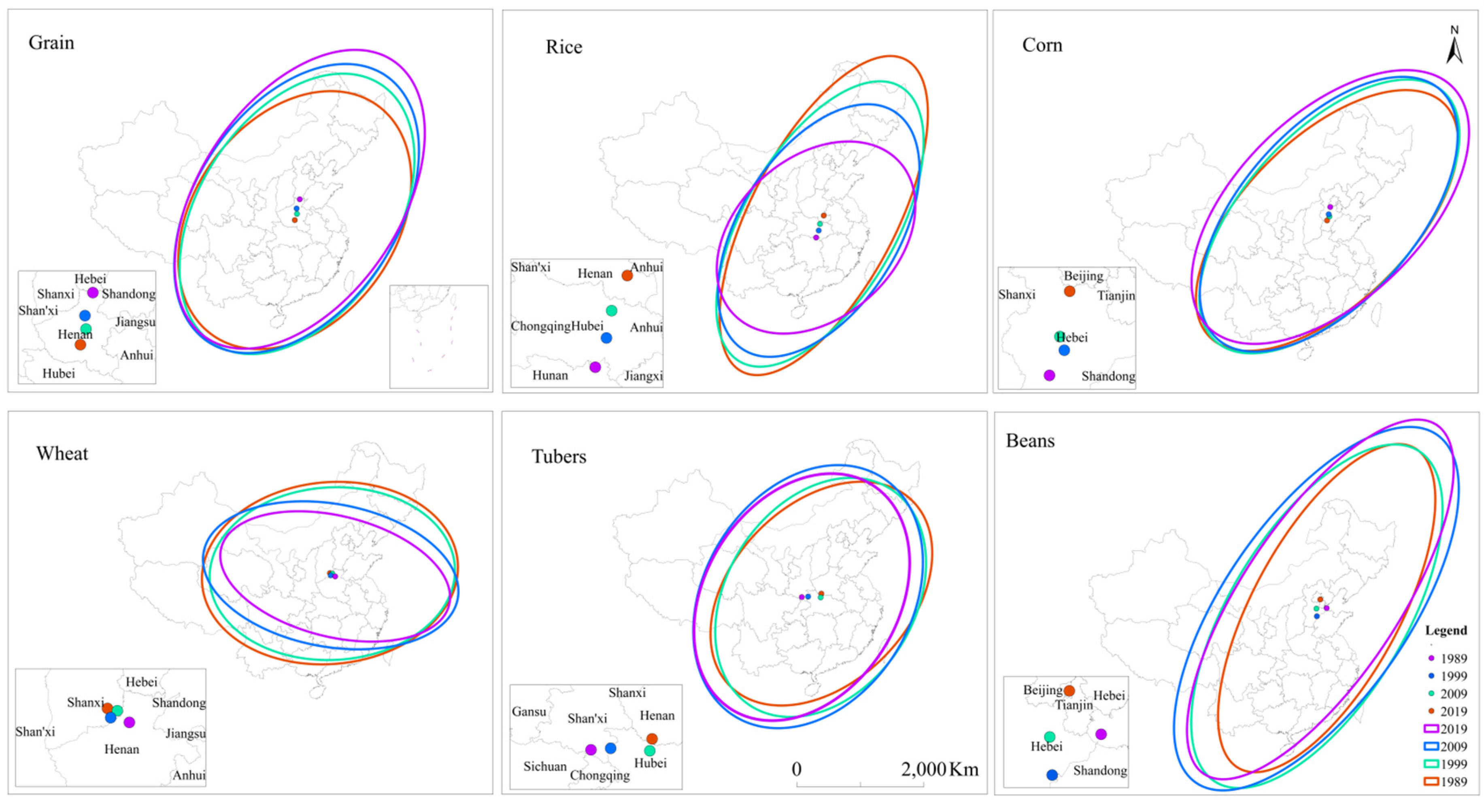

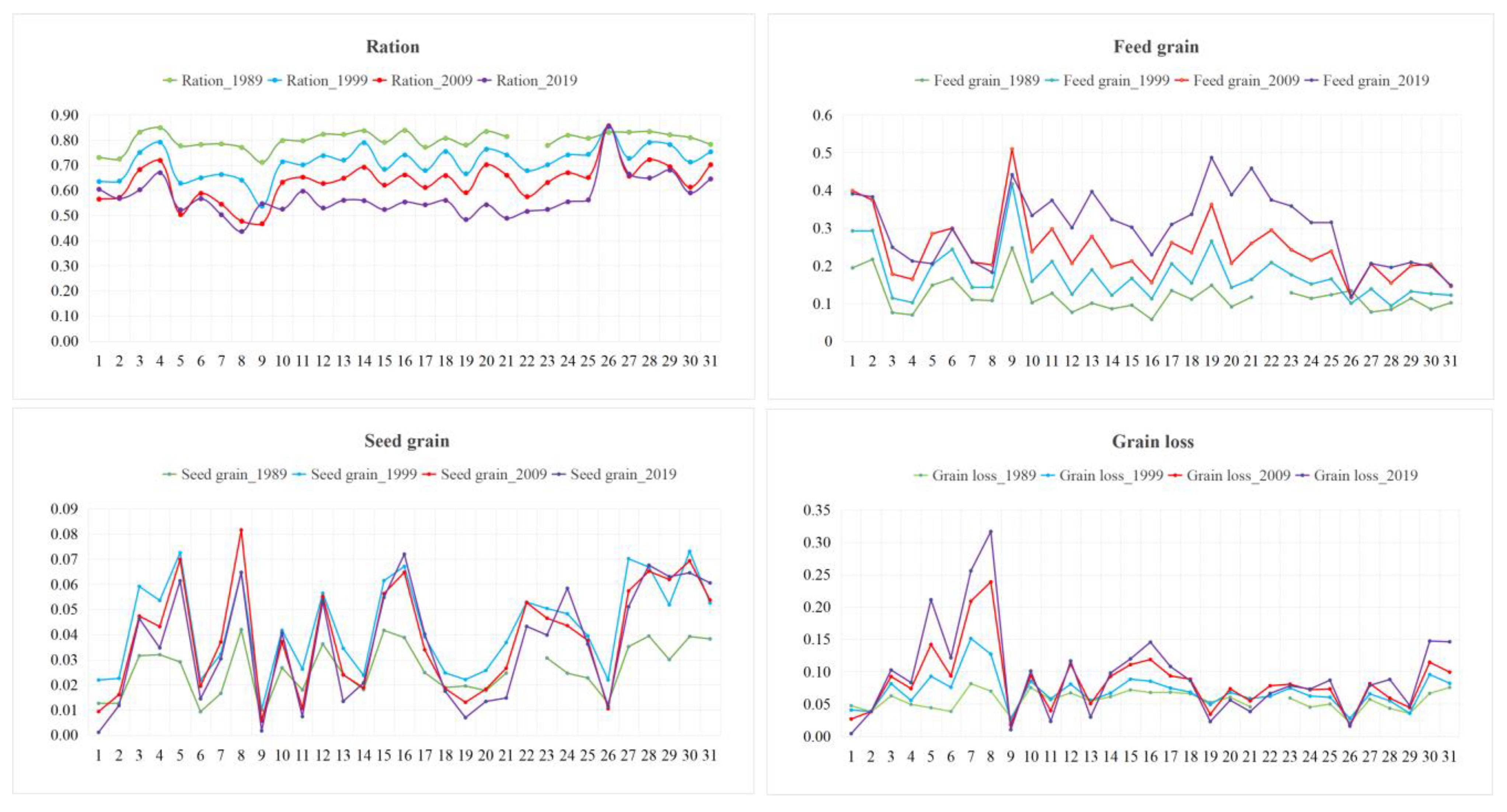
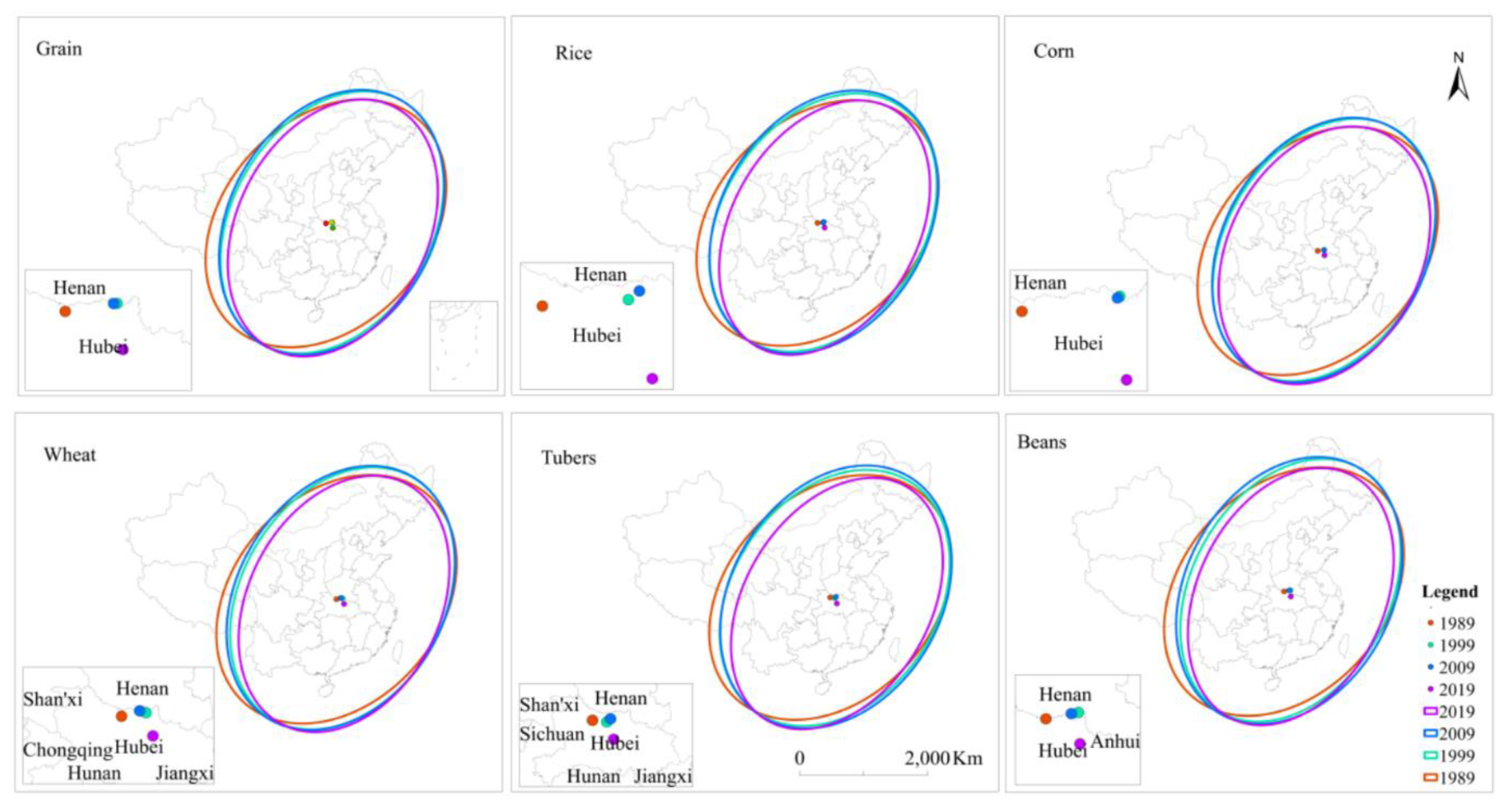
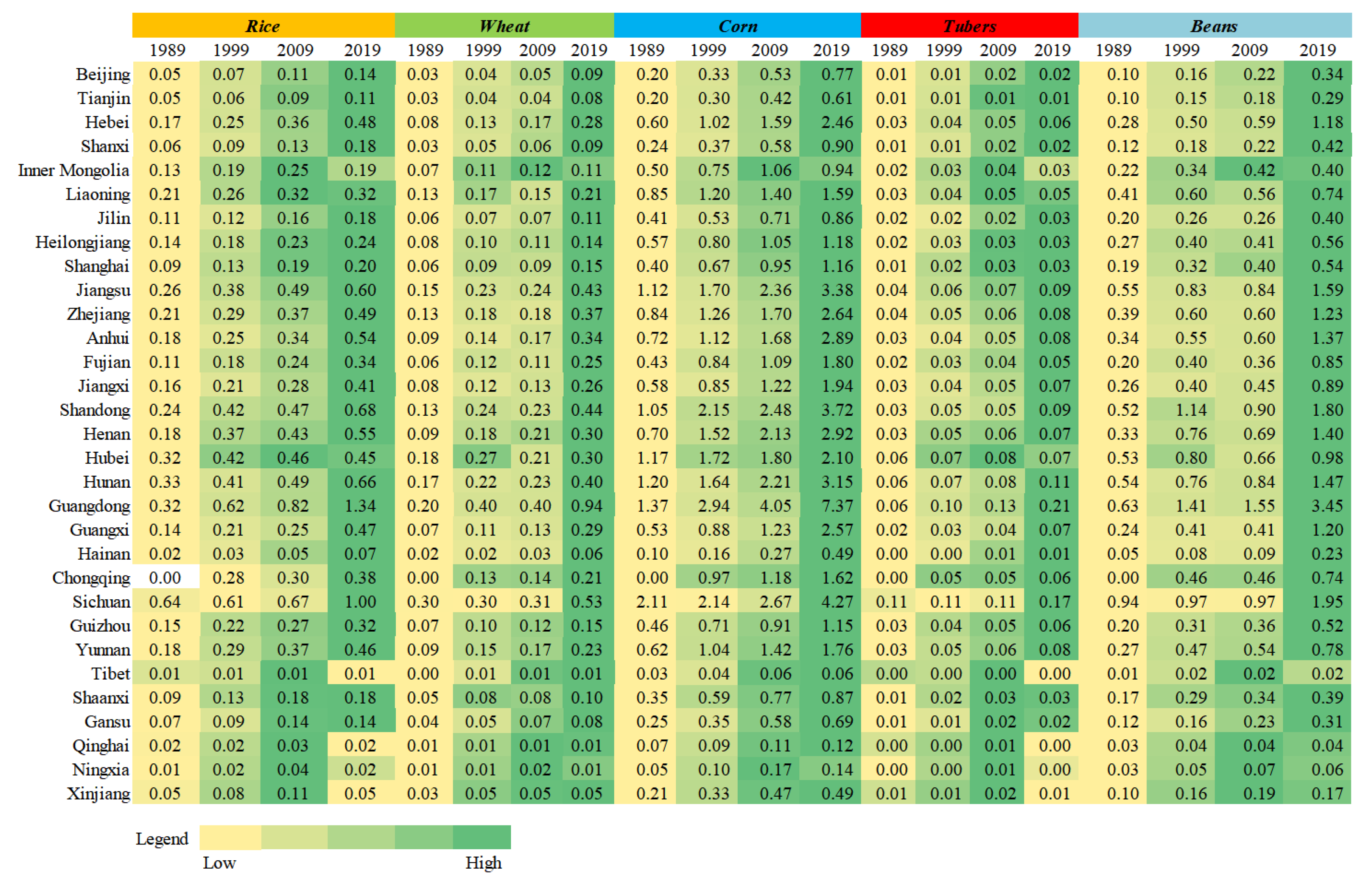
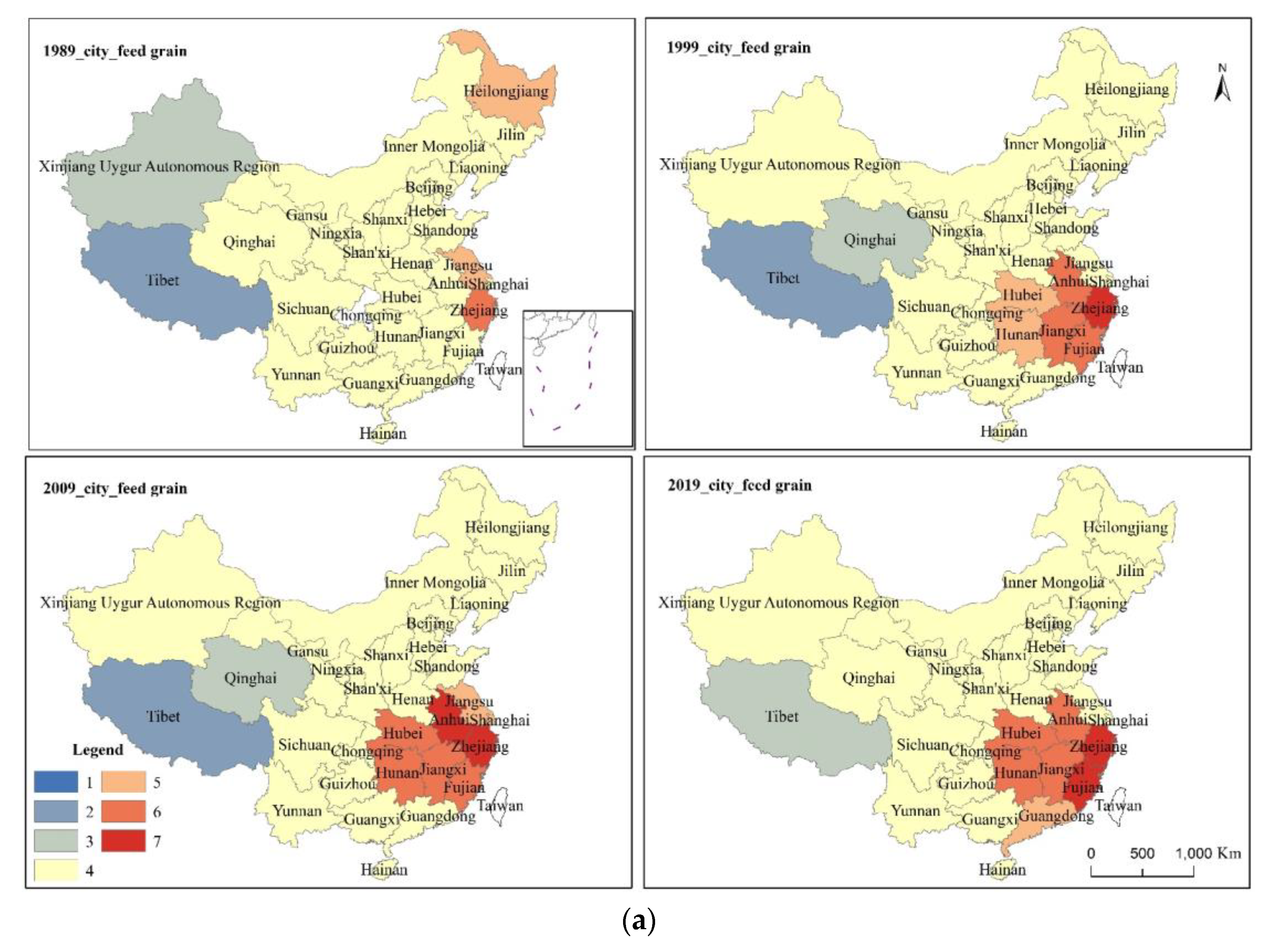
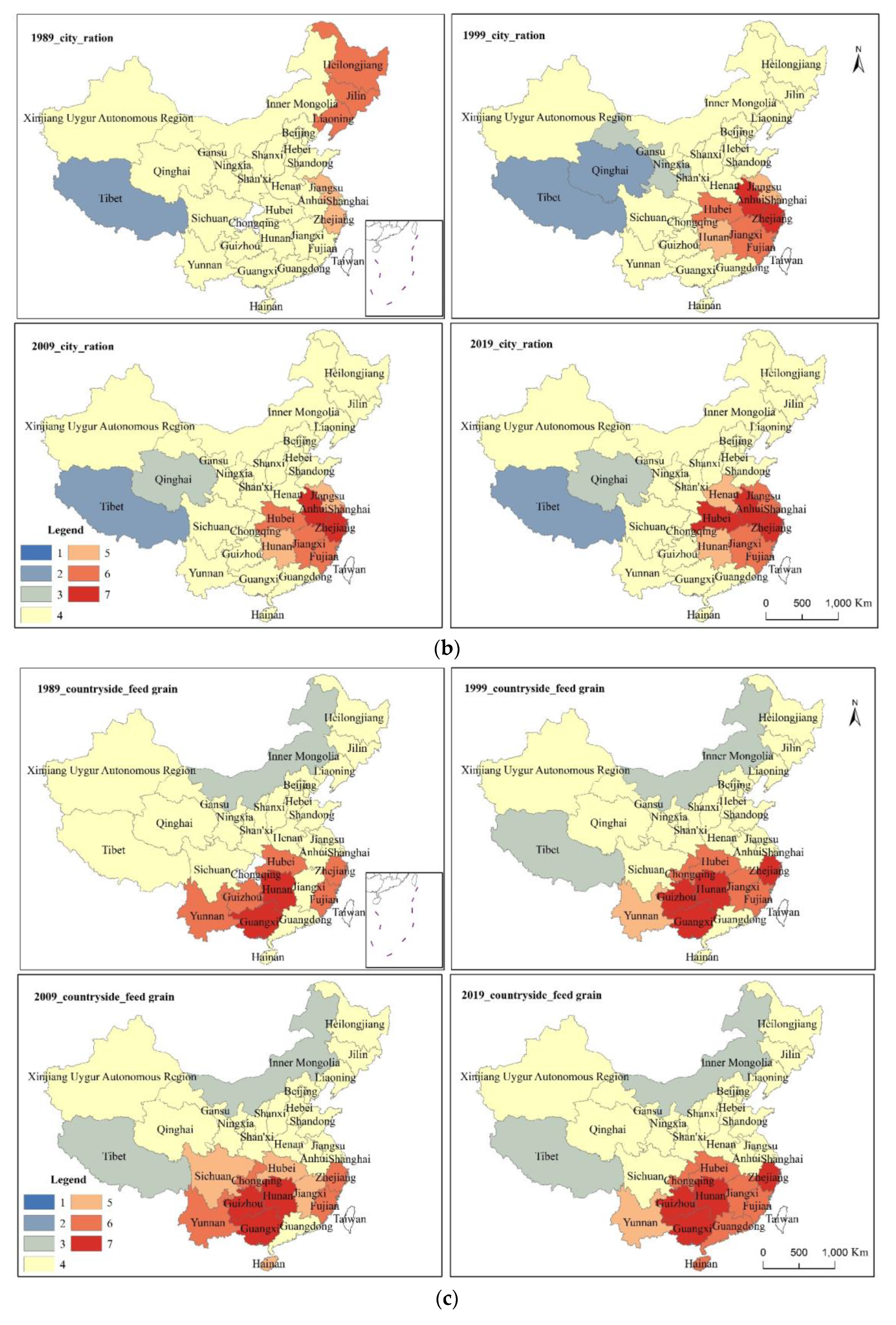





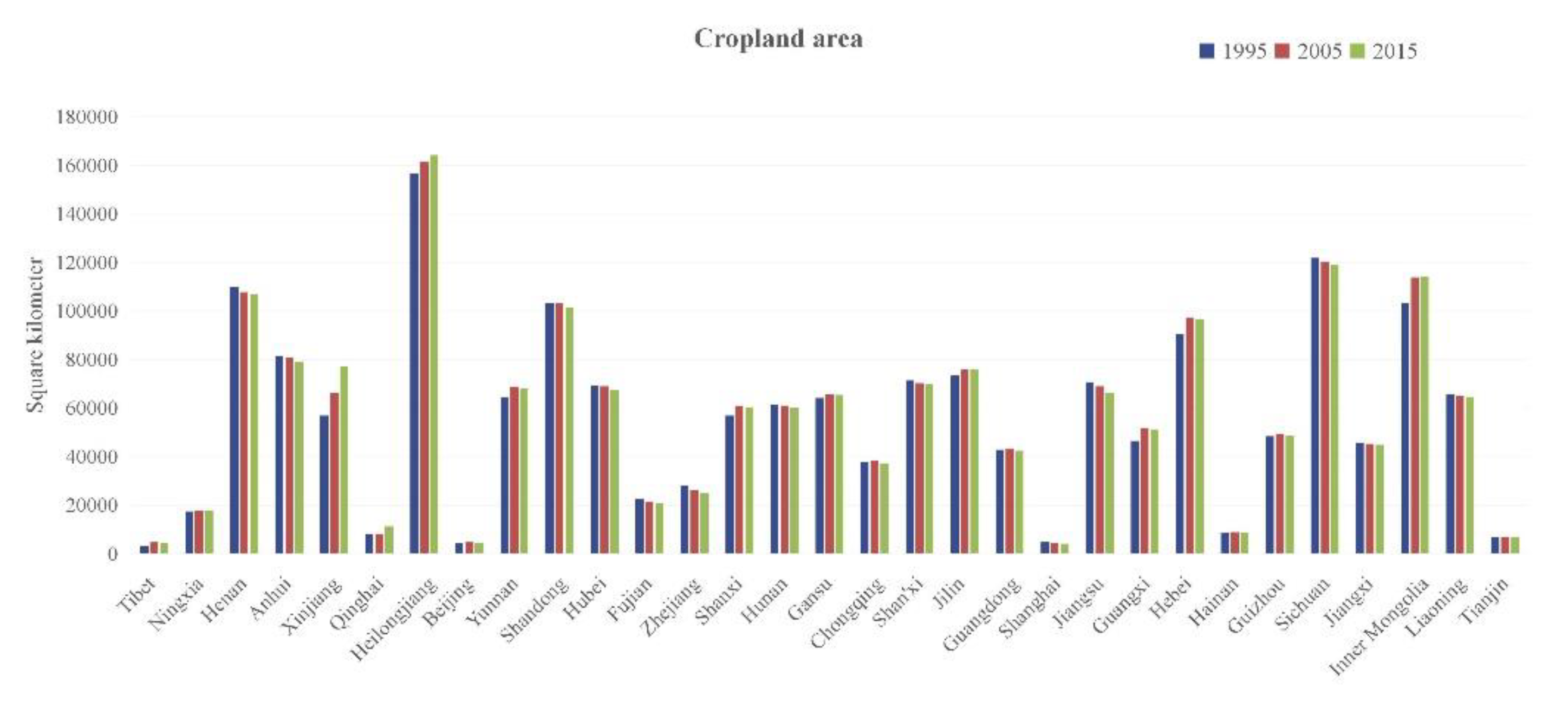
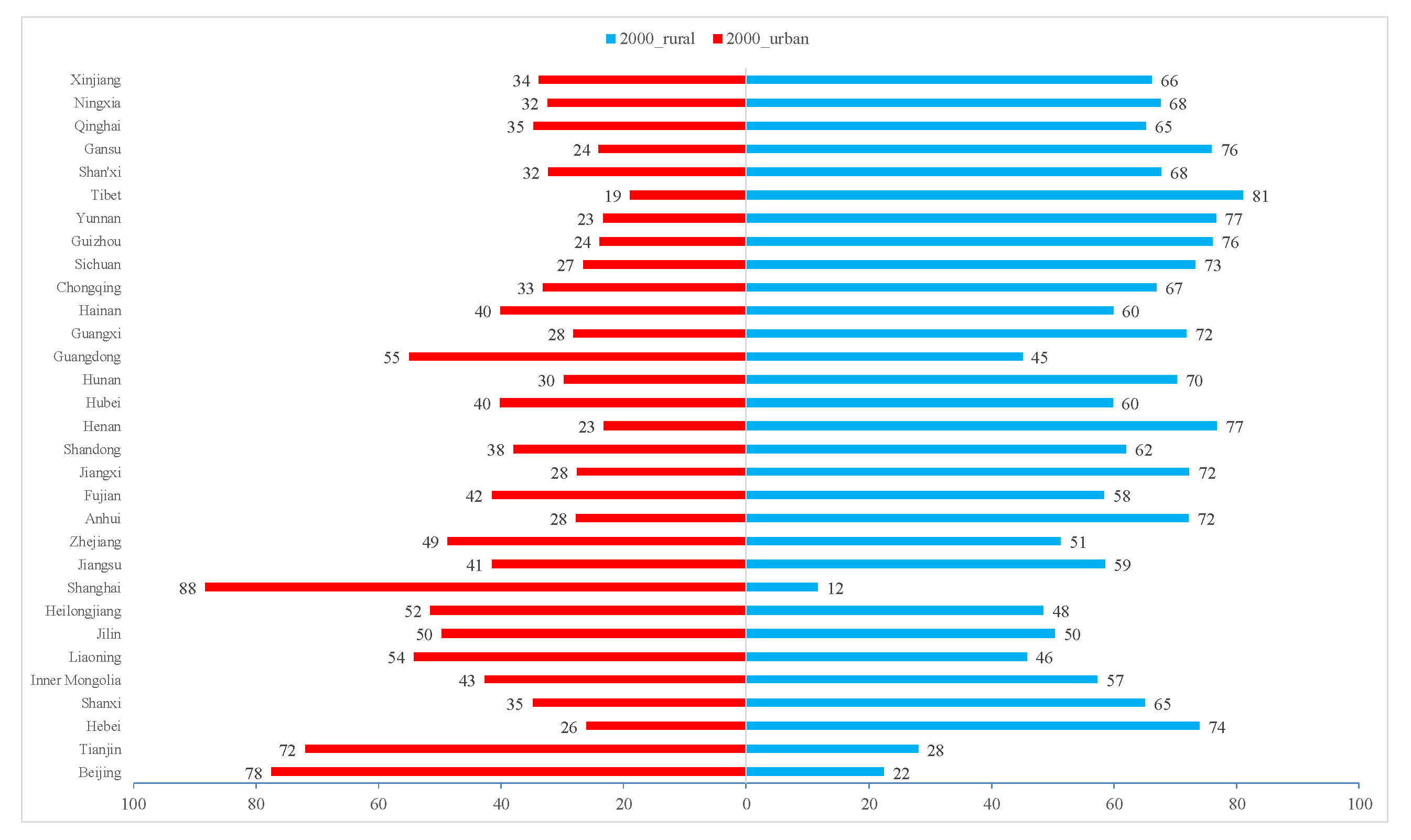
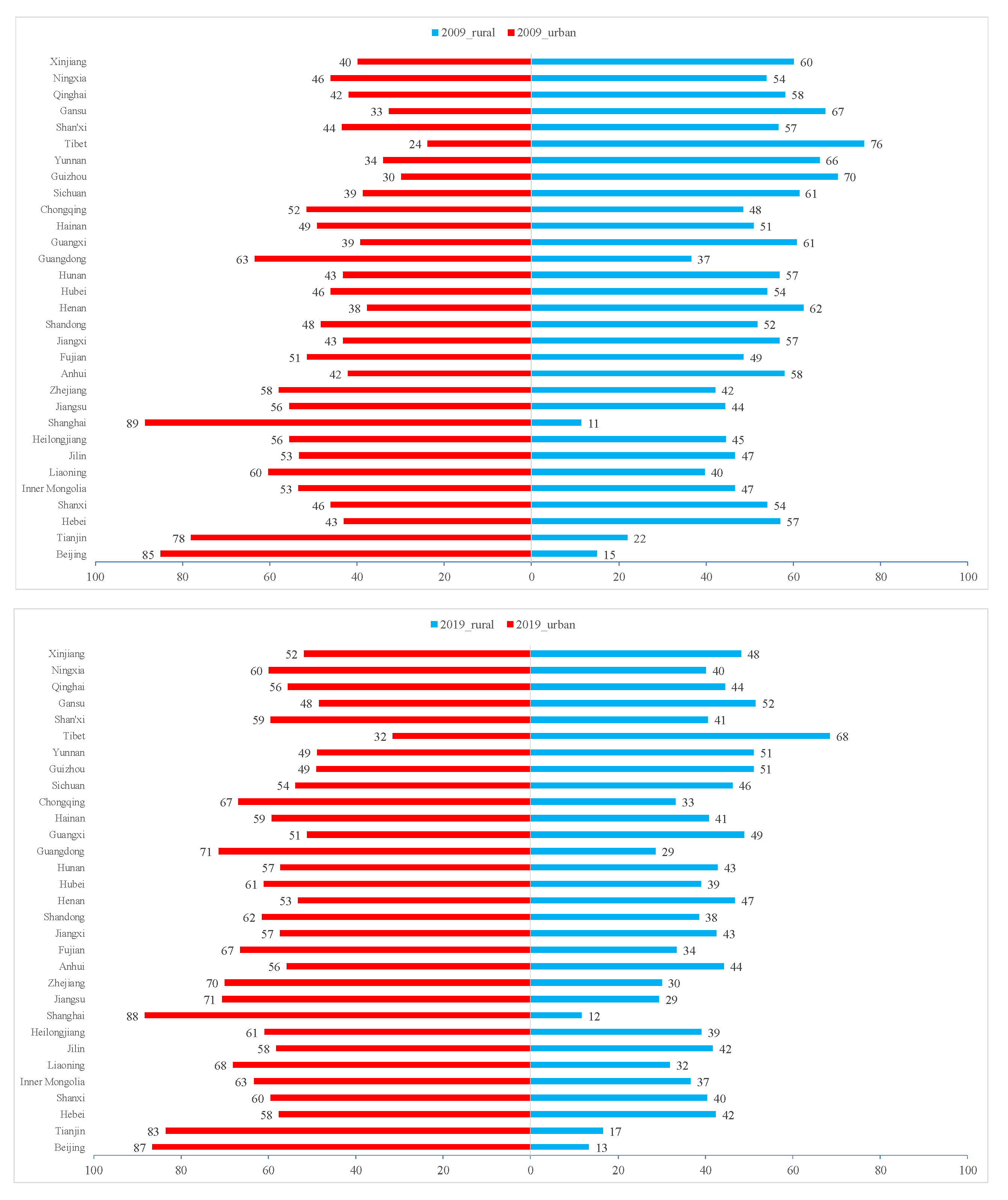
| Rice | Wheat | Corn | Tubers | Bean Meal | |
|---|---|---|---|---|---|
| Pig feed | 15.77 | 6.7 | 43.57 | 15 | 15 |
| Beef cattle feed | 0 | 5.00 | 26.25 | 0 | 0 |
| Sheep feed | 0 | 5.00 | 26.25 | 0 | 0 |
| Cow feed | 0 | 0.7 | 31.40 | 0 | 0 |
| Poultry feed for egg | 6.20 | 2.7 | 40.40 | 0 | 20 |
| Poultry feed for meat | 2.32 | 2.33 | 50.82 | 0 | 20 |
| Aquatic product feed | 0 | 7.08 | 23.39 | 0 | 10 |
| Factor | Variable | |
|---|---|---|
| Grain yield | Resource endowment | Grain sown area |
| Irrigation and water conservancy | Effective irrigation area | |
| Agricultural material input | Fertilizer consumption | |
| Agricultural mechanization level | Total power of agricultural machinery | |
| Grain consumption | Urbanization level | Proportion of urban population |
| Dietary differences | Dietary differences between the north and the south | |
| Living standard of residents | Per capita consumption expenditure of rural residents | |
| Per capita consumption expenditure of urban residents |
| Year | Grain | Rice | Wheat | Corn | Tubers | Beans |
|---|---|---|---|---|---|---|
| 1989 | 408 | 181 | 99 | 87 | 29 | 11 |
| 1999 | 508 | 199 | 127 | 139 | 38 | 20 |
| 2009 | 531 | 196 | 127 | 179 | 31 | 20 |
| 2019 | 664 | 210 | 148 | 281 | 30 | 22 |
| Grain | Rice | Corn | Wheat | Tubers | Beans | |
|---|---|---|---|---|---|---|
| 1989 | 0.285 | 0.289 | 0.500 | 0.292 | 0.315 | 0.599 |
| 1999 | 0.363 | 0.440 | 0.500 | 0.298 | 0.275 | 0.551 |
| 2009 | 0.367 | 0.524 | 0.480 | 0.448 | 0.259 | 0.564 |
| 2019 | 0.400 | 0.588 | 0.458 | 0.486 | 0.270 | 0.627 |
| Year | Ration | Proportion | Feed Grain | Proportion | Seed Grain | Proportion | Grain Loss | Proportion |
|---|---|---|---|---|---|---|---|---|
| 1989 | 254 | 80% | 36 | 11% | 9 | 3% | 19 | 6% |
| 1999 | 238 | 71% | 53 | 17% | 149 | 5% | 25 | 7% |
| 2009 | 181 | 63% | 67 | 24% | 12 | 4% | 26 | 9% |
| 2019 | 180 | 55% | 103 | 31% | 12 | 4% | 33 | 10% |
| Grain | Rice | Corn | Wheat | Tubers | Beans | |
|---|---|---|---|---|---|---|
| 1989 | 0.293 | 0.291 | 0.293 | 0.287 | 0.284 | 0.297 |
| 1999 | 0.294 | 0.284 | 0.295 | 0.283 | 0.266 | 0.303 |
| 2009 | 0.277 | 0.275 | 0.280 | 0.272 | 0.264 | 0.276 |
| 2019 | 0.303 | 0.328 | 0.292 | 0.299 | 0.328 | 0.319 |
| Year | A | B | C | D | E | G | H | I |
|---|---|---|---|---|---|---|---|---|
| 1989 | 0.260 | 0.240 | 0.262 | 0.152 | 0.248 | 0.081 | 0.204 | 0.145 |
| 1999 | 0.334 | 0.233 | 0.240 | 0.205 | 0.171 | 0.119 | 0.243 | 0.371 |
| 2009 | 0.321 | 0.475 | 0.269 | 0.430 | 0.272 | 0.144 | 0.383 | 0.333 |
| 2019 | 0.306 | 0.485 | 0.305 | 0.251 | 0.331 | 0.214 | 0.309 | 0.286 |
Publisher’s Note: MDPI stays neutral with regard to jurisdictional claims in published maps and institutional affiliations. |
© 2021 by the authors. Licensee MDPI, Basel, Switzerland. This article is an open access article distributed under the terms and conditions of the Creative Commons Attribution (CC BY) license (https://creativecommons.org/licenses/by/4.0/).
Share and Cite
Niu, Y.; Xie, G.; Xiao, Y.; Liu, J.; Wang, Y.; Luo, Q.; Zou, H.; Gan, S.; Qin, K.; Huang, M. Spatiotemporal Patterns and Determinants of Grain Self-Sufficiency in China. Foods 2021, 10, 747. https://doi.org/10.3390/foods10040747
Niu Y, Xie G, Xiao Y, Liu J, Wang Y, Luo Q, Zou H, Gan S, Qin K, Huang M. Spatiotemporal Patterns and Determinants of Grain Self-Sufficiency in China. Foods. 2021; 10(4):747. https://doi.org/10.3390/foods10040747
Chicago/Turabian StyleNiu, Yingnan, Gaodi Xie, Yu Xiao, Jingya Liu, Yangyang Wang, Qi Luo, Huixia Zou, Shuang Gan, Keyu Qin, and Mengdong Huang. 2021. "Spatiotemporal Patterns and Determinants of Grain Self-Sufficiency in China" Foods 10, no. 4: 747. https://doi.org/10.3390/foods10040747
APA StyleNiu, Y., Xie, G., Xiao, Y., Liu, J., Wang, Y., Luo, Q., Zou, H., Gan, S., Qin, K., & Huang, M. (2021). Spatiotemporal Patterns and Determinants of Grain Self-Sufficiency in China. Foods, 10(4), 747. https://doi.org/10.3390/foods10040747






